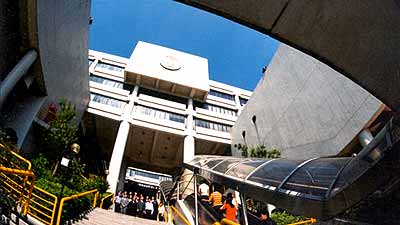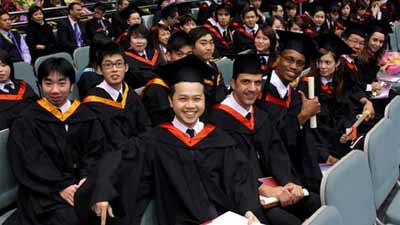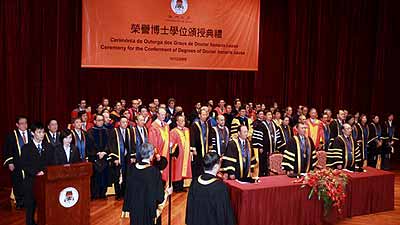


History
The genesis of the University of Macau dates back to March 1981 when its predecessor, the University of East Asia (UEA), was founded by Ricci Island West Limited. Privately owned and the first university in Macao, UEA was established with the assistance of the Government of Macao by a lease of land on Taipa Island, signifying the beginning of modern tertiary education in Macao.
During the first few years after establishment, UEA mainly enrolled students from Hong Kong. To meet the demand for local human resources during the transition period of Macao before its handover to China, the then Macao-Portuguese Government entrusted the purchase of the University to the Macao Foundation in 1988. Subsequent restructuring led to the establishment of the Faculty of Arts, the Faculty of Business Administration, the Faculty of Social Sciences and the Faculty of Science and Technology and to the change of the duration of programmes from three-year to four-year. The Faculties of Law and Education were established afterwards and English remained the main teaching medium.
In 1991, with the promulgation of a new University Charter, UEA was officially renamed the University of Macau, and this new public institution made the nurturing of local Macao talent its prime objective. After a new round of restructuring, the number of students increased greatly, from several hundred to today's more than six thousand while the percentage of local students soared from 39% to 80%.
Over 25 years of steady development has enabled the University of Macau to boast an integrated teaching system organized through five faculties, namely, the Faculty of Business Administration, the Faculty of Education, the Faculty of Law, theFaculty of Social Sciences and Humanities, and the Faculty of Science and Technology and, the Institute of Chinese Medical Sciences and the Honours College. These academic units offer Doctoral, Master's, Bachelor's and Bacharelato (Higher Diploma) degree programmes. English remains the prevailing language in teaching while Chinese, Portuguese and Japanese are used for specialised programmes. Other academic units in the University include the English Language Centre, theCentre for Continuing Education, and the Centre for Macau Studies.
The University has more than 400 faculty members, from countries all over the world and including the United Kingdom, the United States, Canada, Australia, New Zealand, Portugal, Japan, the Chinese Mainland, Taiwan, Hong Kong and Macao. The teaching faculty have rich teaching experience and strong expertise, and some hold PhD degrees awarded by world-famous universities.
The University has always aimed for internationalization, balancing its emphasis on teaching and research. It maintains close relationships with Chinese and overseas institutions, develops research projects with them through mutual cooperation, and has achieved impressive research outputs. The university's academic staff have published articles and papers in more than 100 international refereed academic journals and made world class advances in a number of research areas. The University plays an active part in many international university associations and organizes international conferences of importance with the purpose of allowing the world's experience in higher education to be shared, and so as to promote its own development in teaching and research. Further, the University has provided the government and private institutions with research, development and consulting services in education, economics, business and trade, public policy, science and technology, and engineering.
The Library of the University of Macau is the largest and most technologically advanced in the territory. Currently, it houses more than 300,000 volumes. The depository of publications from international organizations, the Macao collection, and ancient book collection are key features of the Library. The library has also subscribed to over 35,000 e-journals and maintains a collection of more than 100,000 e-books. To further progress towards digitisation, the Library continues to increase online databases and full text databases.
Embracing the rapid development and wide application of new technologies, the University of Macau has pioneered the establishment of a large campus-wide wireless network, covering all classrooms, offices, library and students' hostels. The University enables students to access the Intranet and Internet at home or in the dormitory, bringing great convenience to their study.
Since 1991, the University has established academic links and cooperation with more than 100 institutions of tertiary education in over 20 countries and territories including the Chinese Mainland, Hong Kong, Portugal and other European countries, Japan, Australia, and the United States. The university holds membership of the International Association of Universities, the International Association of University Presidents, the Association of Universities of Asia and the Pacific, and the Association of Portuguese-speaking Universities. The student exchange programmes established with its partners bring over 100 overseas students to the University every year. In addition to the practice of enrolling students from the two special administrative regions and Taiwan, since 2001 the University has been recruiting students from 25 provinces and cities on the Chinese Mainland.
As the largest and leading university in the Macao SAR, the University of Macau considers the provision of quality higher education in Macao one of its prime missions. To fulfill future needs that may arise with the development of Territory, the University is carrying out its expansion plan by building new academic buildings, laboratories, offices, research centres, and student activity centres. In curriculum development, the University will be offering more programmes in response to the needs of Macao society.
On 27 June 2009 the Standing Committee of the National People's Congress adopted a bill that authorized Macao SAR to exercise jurisdiction over the new campus of the University of Macau (UM) upon its completion, signaling a new era in the development of higher education in Macao and also bringing new opportunities for UM. At the groundbreaking ceremony for the new campus Chinese President Mr. Hu Jintao expressed his hope for UM to become a first-class university with first-class facilities, first-class teaching staff, first-class graduates, and first-class achievements. The new campus will offer an environment conducive to innovative learning and research, and will have a far-reaching impact on the development of higher education in Macao. With bigger space on the new campus, UM will be sufficiently equipped to aim for a world-class university and to nurture more outstanding graduates for Macao, China and the world.
The construction of the new campus is ongoing with high speed and quality. It is expected to be completed by the end of 2012. The new campus will cover an area of approximately one square kilometer (with a building area of 820,000 square metres), 20 times larger than the current campus. There will be 80 buildings on the new campus. The new campus will be able to accommodate at least 10,000 students, 70% of whom (approximately 7,000) will be undergraduates, and 30% (approximately 3,000) will be postgraduates. The number of undergraduates at each year of study will be approximately 1,700. There will be approximately eight faculties on the new campus, including the existing Faculty of Business Administration, Faculty of Education, Faculty of Law, Faculty of Science and Technology, Faculty of Social Sciences and Humanities (which will be divided into two separate faculties, Faculty of Social Sciences and Faculty of Arts), and at least one new faculty: Faculty of Life Science and Health.
UM will set up approximately ten residential colleges (RC) on the new campus, in order to realize whole-person education, provide a caring and cultural-rich environment for students, and create a free, stimulating academic atmosphere that facilitates cross-disciplinary interaction. Each RC will have its own culture and characteristics and will allow teachers and students from different cultural backgrounds to learn from and motivate one another and grow together. There will be three open research bases on the new campus. These research bases will hopefully further the exchange and cooperation, in the development of new technologies, between UM and other universities in Macao and mainland China, thereby advancing the development of new-technologies industries in Macao and mainland China. The new campus will not only become a new landmark of Macao, but will also greatly contribute to students' growth and scientific development.